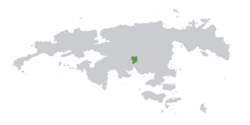Rinava
This article is incomplete because it is pending further input from participants, or it is a work-in-progress by one author. Please comment on this article's talk page to share your input, comments and questions. Note: To contribute to this article, you may need to seek help from the author(s) of this page. |
Kingdom of Rinava | |
|---|---|
| Motto: "Král. Svornosť. Bratstvo." "King. Unity. Brotherhood." | |
| Anthem: "V Roku 1826" ("In the year of 1826") | |
 Location of Rinava in Argis | |
| Capital and largest city | Kalava |
| Official languages | Rinavan |
| Recognised regional languages | Dolch |
| Ethnic groups (2020) | 73.9% Rinavans 20.5% Dolch 2.2% Ustokans 2.1% Litts 1.3% Others |
| Religion (2020) |
|
| Demonym(s) | Rinavan |
| Government | Unitary constitutional monarchy |
• Monarch | Jelena II |
• Prime Minister | Martin Sidor |
| Legislature | Parliament |
| National Council | |
| National Assembly | |
| Establishment | |
• Unification of Rinava | 960 |
• Independence from Ahrana | 1826 |
• First constitution | 1851 |
| Area | |
• Total | 91,340 km2 (35,270 sq mi) |
| Population | |
• 2024 census | 11,073,700 |
• Density | 121/km2 (313.4/sq mi) |
| GDP (nominal) | 2024 estimate |
• Total | 289.2 billion AD$ |
• Per capita | 26,120 AD$ |
| Gini (2022) | low |
| HDI (2022) | very high |
| Currency | Rinavan Tolar (RNT) |
| Time zone | UTC-1 (DIT) |
| Date format | dd.mm.yyyy |
| Driving side | right |
| Calling code | +622 |
| Internet TLD | .ri |
Rinava, officially the Kingdom of Rinava (Rinavan:Rinavské Královstvo) is a landlocked country located in Central Argis, bordering Lusuviya to the west, Dazhdinia to the south, Walneria to the south-east and Littland to the north. Its territory spans 91,340 km2 and hosts a population of more than 11 million. The capital of the country is Kalava, which is also the largest city, followed by Kelpurk and Jelšava. Rinava is a democratic constitutional hereditary monarchy with a parliamentary system.
History
Bronze Age
During the Bronze Age, the geographical territory of modern-day Rinava was home to several tribal cultures. While there is an absence of written records from this era, excavations of local hill forts and burial mounds document the substantial development of trade and manufacture during that period. High-quality bronze weapons and tools were found along with a diverse array of jewelry and coins. Of special note is jewelry made of amber, hinting at a potential trade route passing through this territory, connecting the Amber Lake with civilizations further south, along the Green Sea.
Yasic settlement
Yasic tribes started to arrive in the area of modern-day Rinava at the end of the 6th and beginning of the 7th century from the west, through the area that would later become Lusuviya. These tribes settled mostly in valleys, particularly along the Nava River and its tributaries. There they built fortified settlements, independent from one another, and each ruled by its own ruler called vladyka. Major settlements were the ones at sites of present-day Hromov, Kalava, Ojvín, Stolec, and, especially, Jelšava. During the 7th century, the settlements in northernmost regions suffered from frequent conflicts with Littish tribes.
The oldest written source for this era is the Velmud's Chronicle, which was written in the 10th century by a monk called Velmud of Stolec and mostly focuses on the exploits of Jelšavan vladykas. However, the historical authenticity of his accounts is being questioned by modern scholars. One of his apocryphal stories describes the origin of Rinavan guard dogs and how they become symbols of both Jelšava and its ruling family by alerting the settlement of an impending raid of a rival vladyka's army.
Jelšavan Kingdom (960-1526)
The beginning of the 10th century started a period of centralization when many of the smaller settlements became vassals (whether willingly or through conquest) of one of the more powerful vladykas, who soon started to claim ducal titles. The largest confederation was built by Duke Radovít of Jelšava, who gained control of the entire central highlands and Nava basin, while the northern lowlands came under the influence of the Duchy of Hromov. In 958, with the successful Siege of Hromov, Radovít managed to unite the two duchies.

